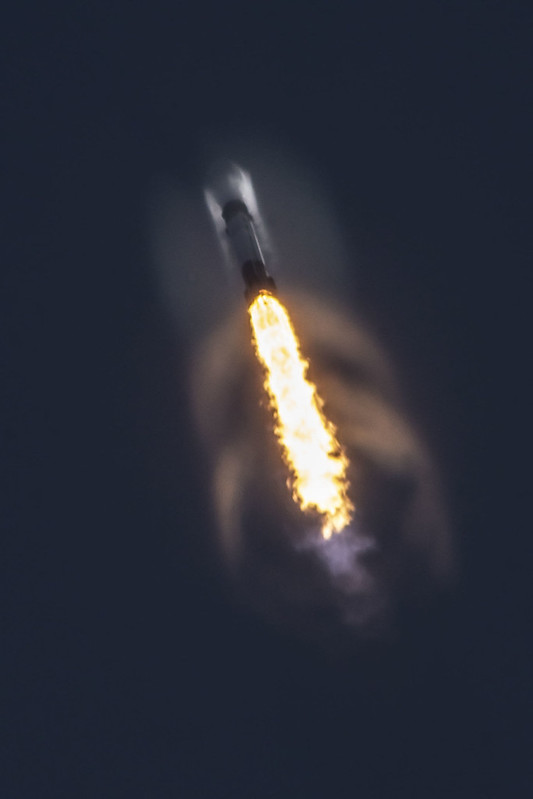MISSION OVERVIEW
SpaceX is targeting Wednesday, April 22 at 3:30 p.m. EDT, or 19:30 p.m. UTC,
for its seventh launch of Starlink satellites. Falcon 9 will lift off from Launch
Complex 39A (LC-39A) at NASA’s Kennedy Space Center in Florida. A backup
opportunity is available on Thursday, April 23 at 3:15 p.m. EDT, or 19:15 UTC.
Falcon 9’s first stage previously supported Crew Dragon’s first flight to the International Space Station, launch of the RADARSAT Constellation Mission,
and the fourth Starlink mission. Following stage separation, SpaceX will land Falcon 9’s first stage on the “Of Course I Still Love You” droneship, which will be stationed in the Atlantic Ocean. Falcon 9’s fairing previously supported the AMOS-17 mission.
The Starlink satellites will deploy in an elliptical orbit approximately 15 minutes after liftoff. Prior to orbit raise, SpaceX engineers will conduct data reviews to ensure all Starlink satellites are operating as intended. Once the checkouts are complete, the satellites will then use their onboard ion thrusters to move into their intended orbits and operational altitude of 550 km
MISSION TIMELINE (all times approximate)
- 00:38:00 SpaceX Launch Director verifies go for propellant load
- 00:35:00 RP-1 (rocket grade kerosene) loading underway
- 00:35:00 1st stage LOX (liquid oxygen) loading underway
- 00:16:00 2nd stage LOX loading underway
- 00:07:00 Falcon 9 begins engine chill prior to launch
- 00:01:00 Command flight computer to begin final prelaunch checks
- 00:01:00 Propellant tank pressurization to flight pressure begins
- 00:00:45 SpaceX Launch Director verifies go for launch
- 00:00:03 Engine controller commands engine ignition sequence to start
- 00:00:00 Falcon 9 liftoff
00:01:12 Max Q (moment of peak mechanical stress on the rocket)
00:02:32 1st stage main engine cutoff (MECO)
00:02:35 1st and 2nd stages separate
00:02:43 2nd stage engine starts
00:03:07 Fairing deployment
00:07:04 1st stage entry burn complete
00:08:45 1st stage landing
00:08:55 2nd stage engine cutoff (SECO-1)
00:14:51 Starlink satellites begin deployment
SpaceX launched its seventh batch of Starlink satellites on a Falcon 9 rocket April 22, growing its internet constellation to 422 satellites in low Earth orbit.
The Falcon 9 lifted off at 3:30 p.m. Eastern from Cape Canaveral Air Force Station in Florida, releasing its payload of 60 satellites 15 minutes later at an altitude of 224 kilometers above the Earth. There the 260-kilogram satellites will complete testing before climbing to an operational altitude of 550-kilometers using their onboard propulsion.
SpaceX landed the Falcon 9’s first stage almost nine minutes after lift off. The same booster had completed three earlier launches, all to low Earth orbit. SpaceX also reused the payload fairings from an August launch carrying the Amos-17 telecommunications satellite for Spacecom.
SpaceX now has enough Starlink satellites orbiting to start limited service in northern geographies, according to a teleconference SpaceX CEO Elon Musk gave in May 2019. Musk said Starlink needed at least 400 satellites to start partial geographic service.
SpaceX did not respond to SpaceNews inquiries April 13 and April 20 about when it will start service. The company reiterated in a mission overview document for its April 22 launch that service in Canada and the Northern U.S. should start this year, followed by near-global coverage in 2021.
SpaceX has FCC permission to operate nearly 1,600 Ku- and Ka-band satellites at 550 kilometers. Recently the company asked the FCC for authorization to fly another 2,800 at that altitude. SpaceX is planning a constellation of up to 12,000, or potentially 42,000 internet satellites, according to filings with U.S. and international regulators.





















Add Comment